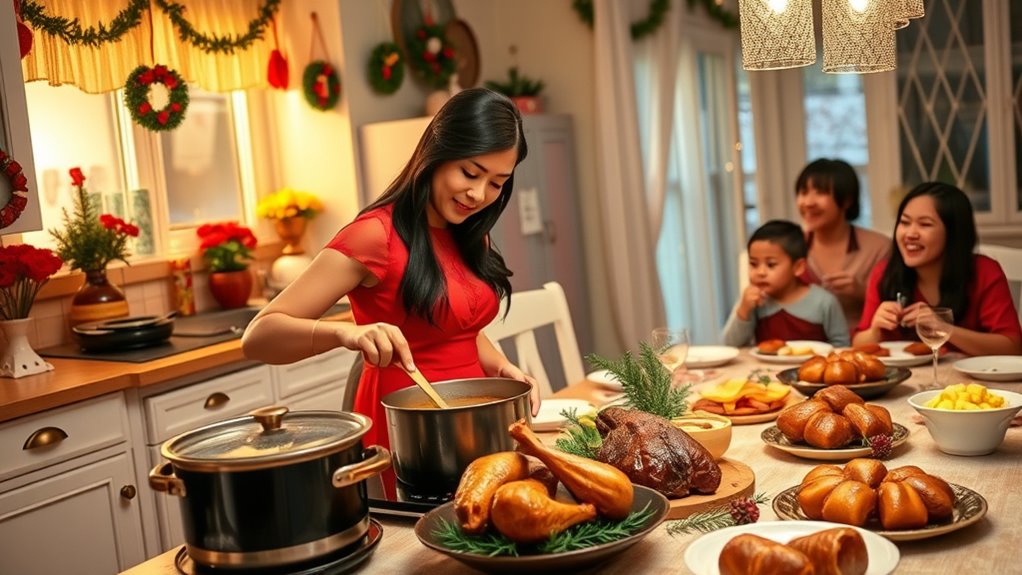Expect a lively Christmas filled with family gatherings, delicious food, and heartfelt traditions when celebrating with your Filipina wife. Noche Buena will be the highlight, featuring a feast after Midnight Mass. You’ll see impressive parols beautifully adorning homes. Traditional dishes like lechon and sweet treats will surely delight your taste buds. Participate in meaningful religious practices, and enjoy the warmth of community festivities. There’s so much more to savor and experience in this rich celebration.
Key Takeaways
- Expect vibrant family gatherings filled with laughter, food, and traditions that emphasize respect for elders through gestures like *mano po*.
- Participate in Noche Buena, a significant feast after Midnight Mass featuring traditional dishes like lechon, ham, and regional specialties.
- Enjoy festive decorations, especially the parol, symbolizing the Star of Bethlehem and embodying virtues like Hope, Faith, and Peace.
- Join in community practices like Simbang Gabi, where attending dawn Masses strengthens spiritual connections and family bonds.
- Savor a variety of traditional Filipino foods, including sweet rice cakes, savory dishes, and popular desserts, enhancing the festive experience.
Embracing the Spirit of Family Gatherings
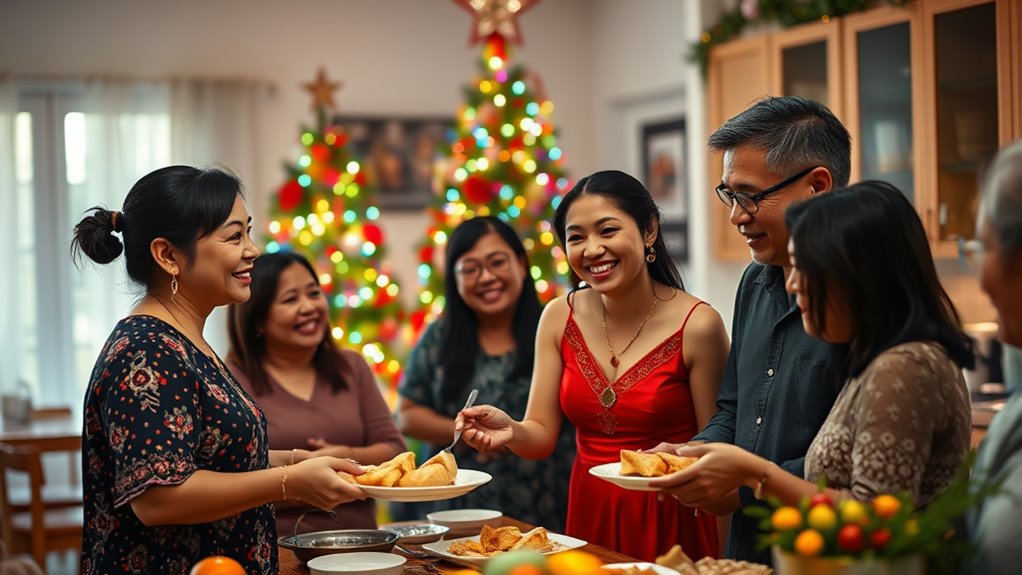
As you celebrate your first Christmas with a Filipina wife, you’ll quickly notice the importance of family gatherings in Filipino culture.
On Christmas Day, visiting extended family, especially elders, is a heartfelt tradition. You’ll pay your respects, greeting them with the *mano po* gesture, a sign of respect that seeks their blessings.
These gatherings often involve large families coming together to enjoy shared meals and stories, fostering inter-generational bonds. The emphasis on family strengthens connections and creates a warm, inclusive atmosphere. In addition to family, you’ll also experience the long Christmas season that begins as early as September.
Large family gatherings foster inter-generational bonds, creating a warm and inclusive atmosphere during Christmas celebrations.
You’ll find that family-oriented customs extend beyond immediate relatives, as neighbors and close friends often join in the festivities, making the celebration even more special.
Embracing these traditions will enrich your experience and deepen your family ties.
The Significance of Noche Buena
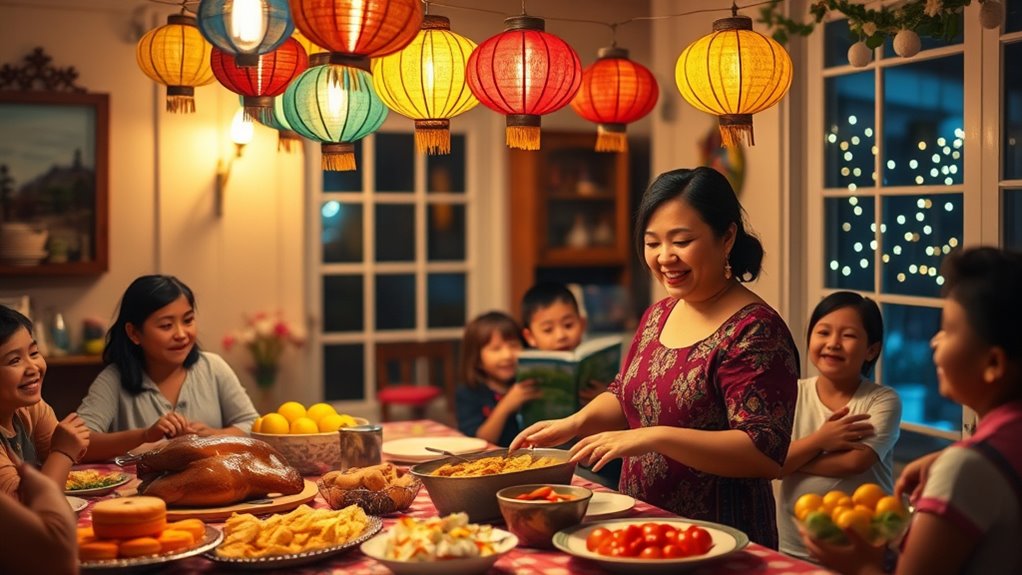
Noche Buena embodies the warmth and joy of the Christmas season, marking a cherished Filipino tradition that brings families together. This “Good Night” feast occurs after the Midnight Mass, symbolizing the birth of Jesus and reinforcing family bonds. Expect to enjoy traditional dishes like lechon, ham, and various regional specialties that reflect local customs. The meal isn’t just about food; it represents love, gratitude, and unity among family members. Families often pray before eating, emphasizing the spiritual aspect of the celebration. The preparations for this gathering often begin weeks in advance, showcasing the spirit of bayanihan as families collaborate to create a festive atmosphere.
Sharing stories and laughter during Noche Buena creates lasting memories, strengthening relationships. You’ll find that this gathering captures the essence of Filipino culture, making it a beautiful and meaningful experience for you and your wife.
Festive Decorations and the Iconic Parol
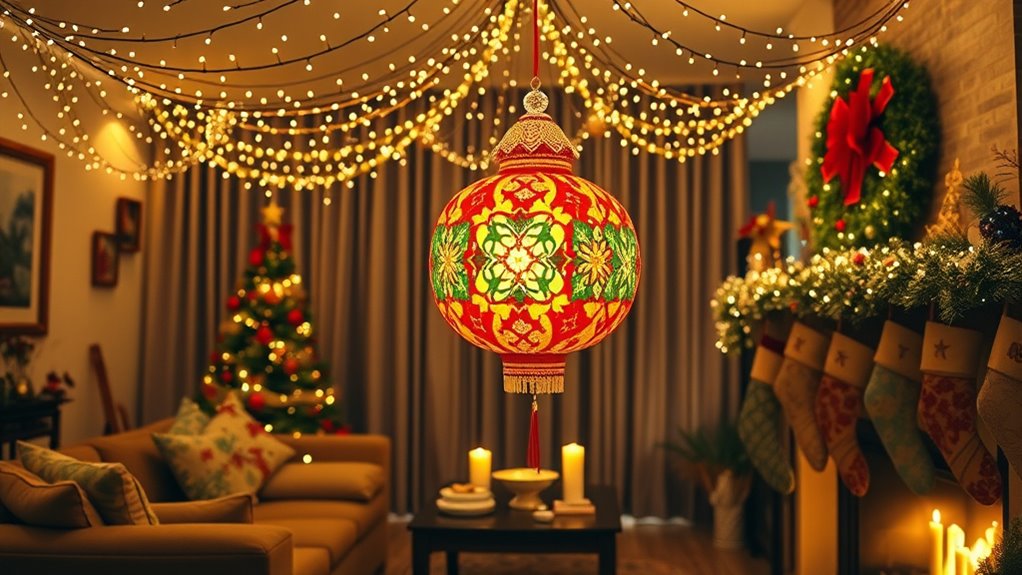
When it comes to festive decorations during the Christmas season, the parol stands out as a beloved symbol of Filipino culture.
Originating in the early 1900s, this five-pointed star represents the Star of Bethlehem, guiding the Wise Men to Christ. Traditionally made from bamboo and papel de hapon, modern parols now use materials like plastic and capiz shells, showcasing vibrant designs and even electronic lights.
You’ll likely see parols hung in windows and public spaces, filling neighborhoods with a warm, inviting glow.
As your wife decorates, she’ll emphasize the parol’s significance—each point symbolizes virtues like Hope, Faith, and Peace. This emphasis on halal lifestyles reflects the broader appreciation for cultural traditions during the holiday season.
This festive spirit fosters a sense of community, making your first Christmas truly memorable.
Traditional Filipino Christmas Foods to Savor
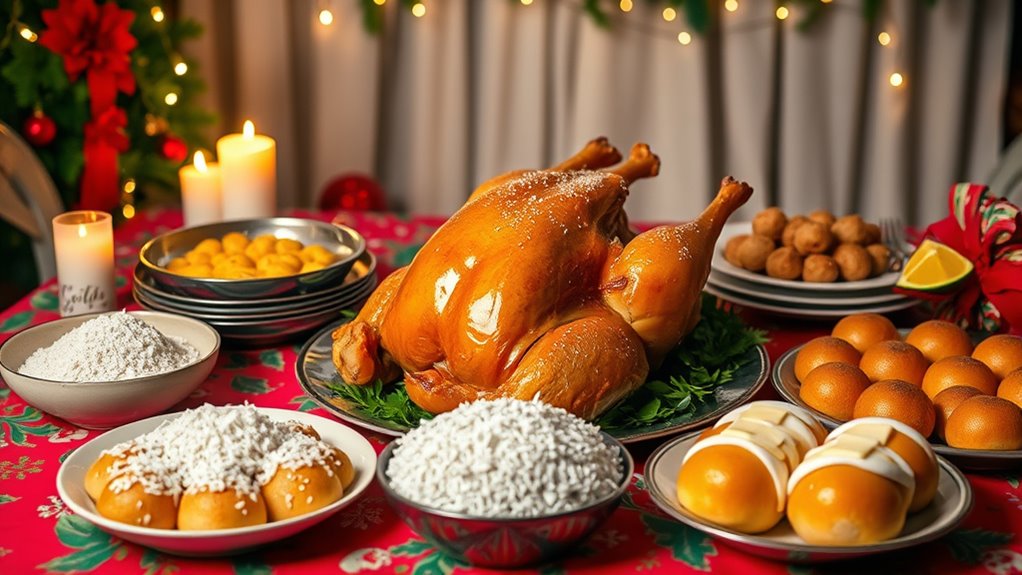
While preparing for your first Christmas with a Filipina wife, you’ll quickly discover that traditional Filipino Christmas foods play a central role in the celebrations.
Expect to see lechon, a whole roasted pig, as the centerpiece of your feast. You’ll also enjoy bibingka and puto bumbong, sweet rice cakes that embody the festive spirit.
Savory dishes like lechon manok, crispy pata, and lumpia will tantalize your taste buds, while menudo and pancit malabon add depth to the meal.
Don’t forget the sweet treats like leche flan and buko pandan salad for dessert. As you sip hot chocolate or fresh juice, you’ll feel the warmth and joy that these delicious dishes bring to the holiday gathering.
Engaging in Religious and Spiritual Practices
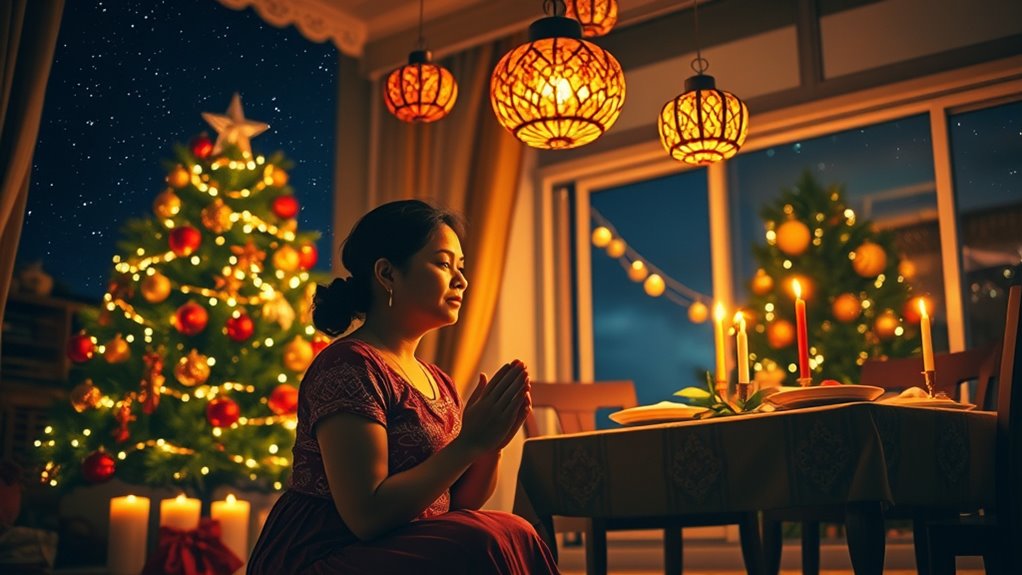
Engaging in religious and spiritual practices is an essential part of celebrating Christmas with a Filipina wife. You’ll likely participate in Simbang Gabi, a series of nine dawn Masses from December 16 to 24. Attending these services at 4:00 or 5:00 AM symbolizes preparation for Jesus’ birth and fosters community unity.
Completing all nine Masses is believed to fulfill prayers, enhancing your spiritual connection. On Christmas Eve, the Misa de Gallo marks the start of festivities.
Within the family, traditional prayers and devotions strengthen bonds, while vibrant decorations like parols and nativity scenes create a festive atmosphere. Embracing these practices not only honors her culture but also deepens your shared faith during this joyous season.
Gift-Giving Traditions and Aguinaldo

Gift-giving traditions during Christmas are a vibrant and cherished aspect of Filipino culture that you’ll want to embrace. Generosity and social connections shine through as families exchange regalo, or gift baskets filled with food items.
Children enthusiastically anticipate aguinaldo, receiving money or toys from their godparents, strengthening familial bonds. As an adult, you might consider personalized gifts, emphasizing thoughtfulness over price.
Participating in Manito-Manita, a Secret Santa tradition, adds an element of surprise to your celebrations. When giving or receiving gifts, present them with both hands to show respect.
Joyful Celebrations and Community Festivities
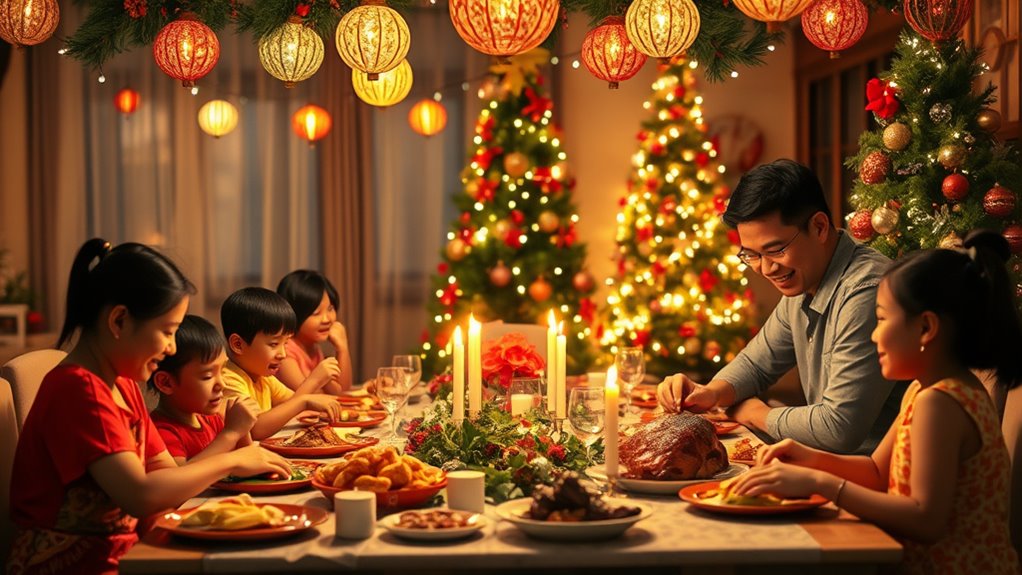
As you immerse yourself in the joyous celebrations of Christmas in the Philippines, you’ll quickly discover that community festivities are at the heart of the season. The vibrant parols light up neighborhoods, symbolizing the Star of Bethlehem, while beautifully crafted belen showcase the nativity scene. The festive spirit is also reflected in global flavors that come alive through traditional Filipino dishes served during this time. In addition to these culinary delights, you can expect local festivals that celebrate the rich cultural heritage of the Philippines, where mood boards can inspire festive decorations and arrangements.
Join the locals for Simbang Gabi, a series of pre-dawn Masses filled with hope and tradition. Afterward, indulge in delicious treats from street vendors, like bibingka and puto bumbong. On Christmas Eve, the Noche Buena feast gathers families for a midnight celebration. Expect lively games, traditional carols, and local performances that bring everyone together. This festive atmosphere fosters community support that is essential for new parents during this special time. Additionally, the Philippines has a strong tradition of community gatherings that enhance the holiday spirit, similar to how neighborhoods come together during events like Simbang Gabi. Your holiday will be filled with warmth, laughter, and a true sense of community.
Frequently Asked Questions
How Long Do Christmas Celebrations Last in the Philippines?
In the Philippines, Christmas celebrations last for an impressive four months, starting in September and wrapping up with the Feast of the Three Kings on the first Sunday of January.
You’ll notice the festive spirit early, with decorations and Christmas carols filling the air. The significance of this long celebration is deeply rooted in the country’s mainly Christian culture, making it a time of joy, family gatherings, and cherished traditions.
What Are the Best Ways to Participate in Simbang Gabi?
Participating in Simbang Gabi is like joining a vibrant tapestry woven with faith and community.
To truly engage, arrive early for the pre-dawn Mass, soaking in the festive atmosphere filled with *parols* and heartfelt songs.
Embrace the spirit by wearing traditional attire and joining in with local choir groups, if you can.
After Mass, indulge in delicious Filipino treats, sharing laughter and stories with fellow attendees, deepening your connection to this beautiful tradition.
Are There Specific Christmas Songs Unique to Filipino Culture?
Yes, there are specific Christmas songs unique to Filipino culture. You’ll find beloved tunes like “Ang Pasko Ay Sumapit” and “Himig Ng Pasko,” which capture the festive spirit.
Songs often blend traditional melodies with modern influences, reflecting the country’s diverse heritage. As you join in community singing, you’ll feel the warmth and connection these songs foster among families and friends.
Embrace this musical tradition; it’s an essential part of Filipino Christmas celebrations!
What Are Common Misconceptions About Filipino Christmas Traditions?
Imagine vibrant parols illuminating the night sky, laughter echoing through festive gatherings. Many think Filipino Christmas celebrations are simple, but that couldn’t be further from the truth.
They’re extravagant, lasting from September to January, with families pouring their income into decorations and feasts. You’ll experience lively karaoke nights and traditional meals like lechon.
Plus, the Nine Mornings (Simbang Gabi) bring communities together in a beautiful blend of faith and joy.
How Can I Prepare for Unexpected Family Gatherings During Christmas?
To prepare for unexpected family gatherings during Christmas, stay flexible and open-minded. Keep your schedule adaptable, as last-minute invites are common.
Familiarize yourself with Filipino traditions, like bringing gifts or sharing dishes, which can help you integrate seamlessly. Communicate openly with family about expectations and boundaries to avoid misunderstandings.
Finally, engage in conversations, actively listen, and show genuine interest in family customs to foster connections and create memorable experiences.
Conclusion
As you immerse yourself in your first Christmas with your Filipina wife, you might find yourself overwhelmed by the warmth and joy of the celebrations. Ironically, you may have expected a quiet holiday, but instead, you’re swept into a whirlwind of family gatherings, festive foods, and heartfelt traditions. Embrace the chaos; it’s a beautiful reminder that the true spirit of Christmas isn’t about silence but about love, laughter, and the togetherness that fills your home—and your heart.
